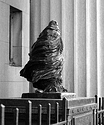Ah physics

Anyway, the basic point, for those who care to know, is that lens design issues tend to reduce resolution at wide apertures, whereas diffraction tends to reduce performance at small apertures. Thus the best performance is typically at intermediate apertures. For RF lenses, the best performance is often seen a stop or two wider open than for SLRs. But that difference is rapidly disappearing now, with all the fancy aspherical corrections etc., assuming you can afford them. Which is a
big "if" for those not earningsteady income from their photography.
What constitutes "best performance" is certainly open for interpretation. What you typically see is center performance at or near its very best when the lens is stopped down a small amount (a stop or two or three) while corner performance is often lacking until ~f/8. When people speak about performance overall, they tend to mean some sort of average across the frame and across all the frequencies. For that reason, the concept of best performance is really never going to sit well with everyone. We all have different needs and preferences.
My [very] broadbrush observation is that RF shooters tend to be a bit biased toward the center performance... due to the focusing mechanism. Whereas SLR users tend to be biased towards the third lines. So when people speak of high performance, it helps to keep these things in mind: how you tend to frame, and what frequency info is important... not to mention colour rendition, which is another subject entirely, since MTF charts are usually shot at one wavelength or two.
At the end of the day, as has been said many times before, you just have to experiment and go with your gut instinct. Its not worthwhile to sweat minor technical details such as only getting 70% performance wide open at the edge of a frame. Most lenses out there will do marvelous rendition, where it matters most, at all reasonable apertures.
If it were possible to quote performance per dollar, the contax G lenses would win, hands down. By a long shot.










